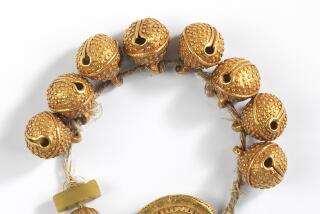Europe Displays Riches in Art Treasured by Africa
- Share via
BRUSSELS, Belgium — Long after colonialism yielded to independence for many African nations, their art is still in the grip of Europe.
Masks, sculptures, ritual objects, jewelry--once mere utensils for African tribes--have become coveted art pieces in Europe. And a show at the Palais des Beaux-Arts here shows interest is still gaining.
African art is so abundant in such former colonial powers as Belgium that the show relied on 50 private collections for material. Organizers say there was no need to tap other sources, such as museums, religious orders and companies with a colonial past to stage the exhibit that has been widely acclaimed.
“In colonial times, the pieces were brought here and stacked away and little happened afterwards,” said Elze Bruyninx, an organizer of the Brussels show. “Now there is increasing interest for their aesthetic qualities.”
As the exhibit demonstrates, private collectors have had a sharp eye for quality. “What we found in private collections was world-class quality,” said Frank Herreman of Antwerp’s ethnographical museum, who helped stage the exhibit.
The show displays 330 pieces, many from central Africa, featuring the severe expressionist lines that mark African art. It includes terra-cotta pieces from Nigeria that are more than 2,000 years old and centuries-old wooden and metal statues and masks from Mali and Mozambique. Many are from the former Belgian colony Zaire, others are from as far away as Angola.
They are on view until mid-June, and already more than 20,000 people have visited the show since it opened in late March.
The richness of European collections has long been a source of misgiving in African nations.
Some, spurred by President Mobutu Sese Seko of Zaire, have in recent decades joined such nations as Greece, which has staged diplomatic protests to focus on the loss of some of its finest art to invading European powers.
Imbata Mosumbe, cultural director of the Zairian Embassy in Brussels, laments that legislation has never been enacted to ensure the return of artworks.
“We wish it would return. We only have moral arguments though, and to rely on morals is a pious wish,” he said.
“Mobutu told the United Nations that the colonial powers had taken everything and that they now had to give it back,” said Huguette Van Geluwe, head of the ethnography department of the Museum of Central Africa near Brussels. One of the world’s biggest treasure troves of African art, it boasts an extensive collection of Zairian art.
Since the waning days of colonialism in the 1960s, some artworks have returned home from former colonial powers, but it has been more a trickle than the flow that African nations wanted.
“African leaders and the intellectuals are now very conscious of its value and appreciate the pieces as art,” said Bruyninx.
However, this was not always so. What is now called African art often had its origins as simple utensils. African masks and sculptures had medical or protective functions. The notion of “art for art’s sake” was a novel concept of Africa’s colonizers.
“From the moment an object lost its function it became worthless,” Bruyninx said. Often, they rotted in the tropical conditions or were even ritually destroyed.
“As a pure art object, it was seldom of value,” she said.
Europe soon changed that. After the utensils and other objects came to Europe as exotic curiosities, some European artists, including Pablo Picasso, created an active interest by blending African art into their own works.
Bruyninx said the objects were well cared for in Europe, where African art became a phenomenon in its own right.
“Many Africans are pleased when they see what has happened with their art here,” Van Geluwe said. “They see it as a showcase for their country.”
The Utotombo exhibit in Brussels, for example, has been endorsed by Zaire’s ambassador here, despite Zaire’s hope of recovering its art from Belgium.
“Contradictions are the spice of life,” Mosumbe said.
Although much African art is now in Europe and the United States, many works are still in Africa, Herreman said.
“What makes it tough for many African nations is that their museums are not suitably” managed to handle the art, he said.
For one thing, there is the lure of money. With some pieces fetching hundreds of thousands of dollars at auctions in the West, some artworks simply disappear from African museums, experts say.
And even when an African museum has a first-right option on national artworks, it often cannot afford them.
More to Read
The biggest entertainment stories
Get our big stories about Hollywood, film, television, music, arts, culture and more right in your inbox as soon as they publish.
You may occasionally receive promotional content from the Los Angeles Times.










